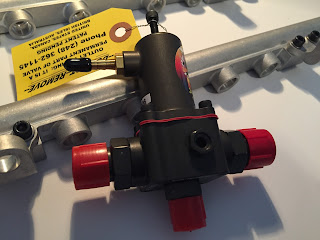Finally have the 427 series 2 wired and running on the test stand. You all saw the build of this back in 2016. In the meantime, I have chosen an aftermarket, motorsport-grade Engine Management System... The Life Racing F88 ECU. This is a professional level ECU, used in countless sports cars and touring car series. It has twin CPUs, one for the time-sensitive engine angle clock, and the other for the various inputs/outputs controlled by the ECU. In my case, I'm running 16 sequentially fired injectors, staged. The primaries will fuel the engine up to about 30% duty cycle, then I'll bring in the secondaries gradually from that point.
Also, a first, this engine is running sequential Coil near Plug ignition coils. I could not find a plug-top boot that I was happy with the fit, so I mounted 8 individual coils under the plenum. Each feeds a custom plug wire for it's particular cylinder. These Bosch coils are the same ones used on current Nascar (Winston, Nextel, Sprint, Monster...) Cup engines.
The custom wiring harness was a joint project with Indy Wiring Services. All mil-spec wires and connectors. Jeremy Gibson is a true professional , and excellent to work with. Overall, the harness turned out great. Could have been 1/2" here or there, but for my amateur measurements, a good fit nonetheless. All Raychem covered, glue-lined shrink boots, etc.
What you see here doesn't have the Kinsler fuel rails and racing pressure regulator. My previous testing revealed some issues with tuning that setup. Simply need more time to troubleshoot it and tune it.
Running on a "from-scratch" calibration, the ECU successfully ran the engine. That is, once I fixed the cam sync. Initially I had the cam tooth 360* out of phase, so the motor would not run on 720-sequential. Easy fix (675-360 = 315 degrees cam sync). And boom! The motor fired up.
I had the idle screw pretty far open to get the motor started, so it idled around 2000 rpm. At this point I don't have the Idle Control valve connected or configured, so I just needed enough throttle opening to get it to run on it's own. I have to say, even with a very rough calibration, the motor barked. With the speed of the processors, and the precision of control, I've never heard an LT5 sound so sweet on the stand. Flicking the throttle blades rev'ed the motor instantly. I can't wait to get this thing fine-tuned.
Anyway, next time I'll video the engine running. For now here's a few pics and a walk-around video.
















